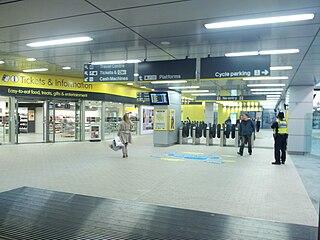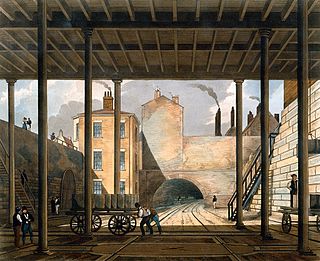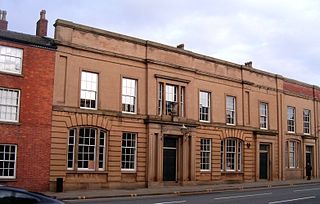
The Rainhill trials were a competition run from the 6 to 14 October 1829, to test George Stephenson's argument that locomotives would have the best motive power for the then nearly-completed Liverpool and Manchester Railway (L&MR). Ten locomotives were entered, of which five were able to compete, running along a 1 mile (1.6 km) length of level track at Rainhill, in Lancashire.

Stephenson's Rocket is an early steam locomotive of 0-2-2 wheel arrangement. It was built for and won the Rainhill Trials of the Liverpool and Manchester Railway (L&MR), held in October 1829 to show that improved locomotives would be more efficient than stationary steam engines.

A tunnel is an underground or undersea passageway. It is dug through surrounding soil, earth or rock, or laid under water, and is usually completely enclosed except for the two portals common at each end, though there may be access and ventilation openings at various points along the length. A pipeline differs significantly from a tunnel, though some recent tunnels have used immersed tube construction techniques rather than traditional tunnel boring methods.

The Liverpool and Manchester Railway (L&MR) was the first inter-city railway in the world. It opened on 15 September 1830 between the Lancashire towns of Liverpool and Manchester in England. It was also the first railway to rely exclusively on locomotives driven by steam power, with no horse-drawn traffic permitted at any time; the first to be entirely double track throughout its length; the first to have a true signalling system; the first to be fully timetabled; and the first to carry mail.

Edge Hill is a district of Liverpool, England, south east of the city centre, bordered by Kensington, Wavertree and Toxteth.

Earlestown railway station is a railway station in Earlestown, Merseyside, England, and one of the few "triangular" stations in Britain.

Crown Street railway station was the Liverpool terminus railway station of the Liverpool and Manchester Railway in Liverpool, England, it opened on 15 September 1830. The station was one of the world's first on an inter-city passenger railway in which all services were operated by mechanical traction.

Wapping or Edge Hill Tunnel in Liverpool, England, is a tunnel route from the Edge Hill junction in the east of the city to the Liverpool south end docks formerly used by trains on the Liverpool-Manchester line railway. The tunnel alignment is roughly east to west. The tunnel was designed by George Stephenson with construction between 1826 and 1829 to enable goods services to operate between Liverpool docks and all locations up to Manchester, as part of the Liverpool and Manchester Railway. It was the first transport tunnel in the world to be bored under a city. The tunnel is 2,030 metres (1.26 mi) long, running downhill from the western end of the 262 metres (860 ft) long Cavendish cutting at Edge Hill in the east of the city, to Park Lane Goods Station near Wapping Dock in the west. The Edge Hill portal is near the former Crown Street Station goods yard. The tunnel passes beneath the Merseyrail Northern Line tunnel approximately a quarter of a mile south of Liverpool Central underground station.

Edge Hill railway station is a railway station that serves the district of Edge Hill, Liverpool, England and is one of the oldest railway stations in the world.

Liverpool Central railway station in Liverpool, England, forms a central hub of the Merseyrail network, being on both the Northern Line and the Wirral Line. The station is located underground on two levels, below the site of a former mainline terminus. It is the busiest station in Liverpool, though considerably smaller than Lime Street station, the mainline terminus, and the busiest station to operate solely on the Merseyrail network. The station is the busiest underground station outside London serving 40,000 people daily. The station in passengers per platform is the busiest underground railway station in the United Kingdom outside of London at 3,979,547 per platform per annum and coming tenth out of all stations outside the capital, underground or overground.

Henry Booth was a British corn merchant, businessman and engineer particularly known as one of the key people behind the construction and management of the pioneering Liverpool and Manchester Railway (L&M), the world's first steam railway conducting both scheduled passenger services and freight.
Edge Hill railway works was built by the Liverpool and Manchester Railway around 1830 at Edge Hill, Liverpool. A second was built in 1839 by the Grand Junction Railway adjacent to it.

Park Lane was the world's first goods terminus on the Liverpool and Manchester Railway serving the south end Liverpool Docks. The station was opened in 1830. Its initial name was Wapping Station. The goods station was accessed from Edge Hill rail junction in the east of the city via the 1.26 miles (2.03 km) long Wapping Tunnel.
The history of rail transport in Great Britain to 1830 covers the period up to the opening of the Liverpool and Manchester Railway, the world's first intercity passenger railway operated solely by steam locomotives. The earliest form of railways, horse-drawn wagonways, originated in Germany in the 16th century. Soon wagonways were also built in Britain. However, the first use of steam locomotives was in Wales. The invention of wrought iron rails, together with Richard Trevithick's pioneering steam locomotive meant that Britain had the first modern railways in the world.

Liverpool Road is a former railway station on the Liverpool and Manchester Railway in Manchester, England; it opened on 15 September 1830. The station was the Manchester terminus of the world's first inter-city passenger railway in which all services were hauled by timetabled steam locomotives. It is the world's oldest surviving terminal railway station. With tracks running at a first floor level behind the building, it could also be considered one of the world's first elevated railway stations.

The Victoria Tunnel in Liverpool, England is a 1.537 miles (2.474 km) long rail tunnel. Opened in 1849, its eastern portal is adjacent to Edge Hill station. The western portal opens into a short cutting, between Byrom Street and Fontenoy Street, the shorter Waterloo Tunnel exits the cutting terminating at Waterloo Dock. The Victoria and Waterloo tunnels are effectively one long tunnel connected by a ventilation cutting. The whole length is generally known as the Waterloo Tunnel.

Edward Woods FRSA was a British civil engineer.
Manchester Oldham Road station opened in 1839 as the terminus station of the Manchester and Leeds Railway (M&LR) in Collyhurst, Manchester. When the M&LR opened Manchester Victoria in 1844 as its new Manchester passenger station Oldham Road was converted to a goods station which it remained until its closure in 1968.
Parkside railway station was an original station on the Liverpool and Manchester Railway. It then became the interchange station between lines when the Wigan Branch Railway opened in 1832, moving to the physical junction of the two lines in 1838. The station continued as an interchange until being by-passed in 1847 when a west curve was opened to facilitate north–south links that did not go through the station. Traffic declined further after the Winwick cut-off opened in 1864 leading to closure in 1878.
Wavertree Lane was one of the original stopping-places on the Liverpool & Manchester Railway which opened in 1830. Stopping-places were commonly located at supervised level crossings where gatekeepers were available to signal trains to stop close to the point at which the line crossed the road, in this case Wavertree Lane. The stopping-places were generally primitive in nature without platform or shelter for passengers. Wavertree Lane appeared in the first official list of stopping-places issued in February 1831. The list was probably issued to reduce the number of informal intermediate stops requested by passengers. In the early days only second class trains made such request stops although mixed class trains were introduced subsequently.

















